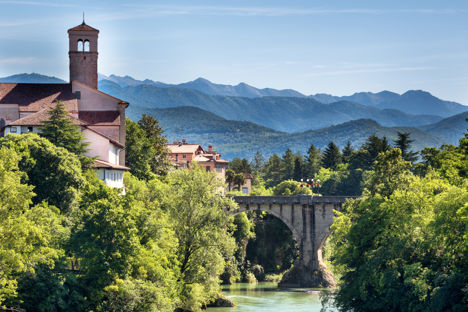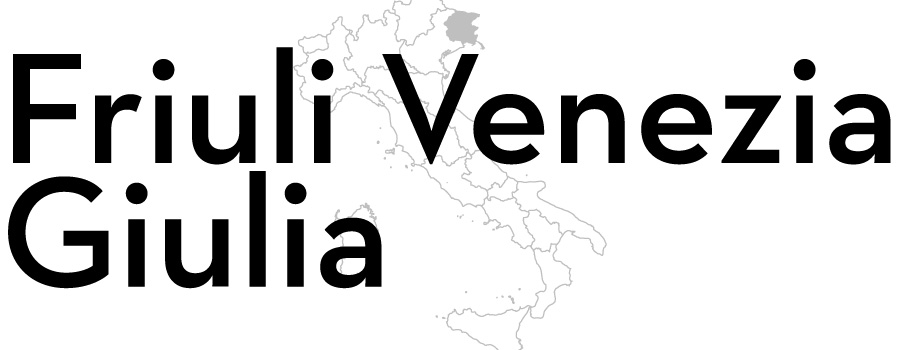
The complete foodie guide to Friuli Venezia Giulia
With jagged alpine mountains, an Adriatic coastline and Austria and Slovenia as neighbours, Friuli Venezia Giulia is a truly unique part of Italy. Get to know all about its iconic ingredients and dishes with our complete guide to the region.
The complete foodie guide to Friuli Venezia Giulia
With jagged alpine mountains, an Adriatic coastline and Austria and Slovenia as neighbours, Friuli Venezia Giulia is a truly unique part of Italy. Get to know all about its iconic ingredients and dishes with our complete guide to the region.
View more from this series:
Italian wineFriuli Venezia Giulia (often simply referred to as Friuli) has the atmosphere of a frontier region. For centuries the area was fought over by Romans, Slavs, Venetians and Austrians, each of which have left their mark on its language, culture and cuisine. Its current borders were only fixed in 1954 when Trieste, which had been administered by the USA and UK since the Second World War, was finally incorporated into Italy. It’s one of the five autonomous Italian regions which reflects its unique character.
The complicated name reflects the unusual make-up of the region. Friuli derives from the latin Forum Iulii, a city founded by Julius Caesar and known today as Cividale del Friuli, sitting right on the Slovenian border. Venezia Giulia is the eastern part of the region, so called because it’s bordered by the Julian Alps. Friuli Venezia Giulia is currently divided into four provinces, two large, and two small. The large – Pordenone and Udine – sit roughly in the area known as Friuli, while the small – Gorizia and Trieste – are in Venezia Giulia.
Friuli Venezia Giulia is the sixth smallest Italian region by population, its residents numbering roughly half those of Rome. The population is mostly of Italian origin but there is a sizeable Slovenian community in the east.
The cuisine of the region is influenced by its history as well as its geography. It contains the Carnic and Julian Alps as well as an Adriatic coastline with a river plain in between. In the west, at Grado, the complex of lagoons which stretches down to Venice begins. Friuli Venezia Giulia has two sizable rivers; the Tagliamento running west to east and the Isonzo running east to west. Both are sources of freshwater fish, which results in a mixed cuisine where hearty mountain dishes meet Mediterranean plates; where Latin meets Germanic and Slavic; where Italy meets her neighbours.
The climate of the region is temperate, even on higher ground, due to the presence of the southerly Scirocco winds which blow up the Adriatic. But Trieste is also often battered by the northerly Bora wind, which regularly reaches up to 150km and hour – causing havoc for residents.
Take a look at the ingredients, dishes and flavours that make up Friuli’s cuisine – something that’s unlike anything else you’ll find in Italy.
Ingredients and flavours
Although not the most famous Italian cured ham internationally, Prosciutto San Daniele is considered to be the superior product by many Italians. Produced in a similar way to Prosciutto di Parma, San Daniele ham must be air dried within the commune of San Daniele, in the province of Udine. The prosciutto is slightly softer in texture, darker in colour and sweeter in flavour than its counterpart from Parma. There’s also Speck di Sauris, a kind of smoked ham produced in the Carnian alps. Unlike Prosciutto San Daniele, it’s cured with smoke from beech wood. Before smoking it’s salted and coated in garlic and pepper which give it a spicy flavour. The smoking makes it a slightly tougher but fuller flavoured meat than prosciutto.
Similar to cotechino, muset is a spiced sausage made from pork offal and is eaten boiled. Its intense flavour comes from the addition of cinnamon, nutmeg, black pepper, coriander and cloves. It’s quite fatty, so it’s regarded as a winter dish and is often eaten around Christmas. Finally, cevapčići is originally a Balkan dish, but has become integral to Friuli over the years. These minced meat sausages are similar to Turkish kebabs, from which the name derives. They are made from a mixture of beef and lamb since they are of Muslim origin, and are an example of the Slavic influence on the cuisine of Friuli Venezia Giulia.
Friuli, like many mountainous regions, produces some incredible cheeses. The chief among these is Montasio, a seasoned cow’s milk cheese made primarily in the province of Udine, but also in Pordenone and Gorizia. It’s a semi-hard cheese, characterized by lots of small holes, with a delicate flavour. Formadi frant (which is Friulan for crushed cheese) could not be more of a contrast to Montasio. It’s strong and soft, almost with the flavour of a blue cheese but without the colour. It’s actually made by mixing offcuts of other cheeses together with black pepper, hence the name. What started as a low-quality cheese is now considered a high-quality artisanal product. Its alpine character betrays its origins in the Carnian alps.
With its large Adriatic coast and lagoon region, Friuli Venezia Giulia has a very similar fish offering to the Veneto. Seasonally fresh fish include sardines and anchovies, octopus, calamari, scallops, crab and mussels to name but a few. Sea bass, sea bream and sole are all found in the Adriatic and therefore in the restaurants and markets of Trieste, Grado and other coastal towns. Trout, carp, and other freshwater fish are also found.
Cren is the local word for horseradish which is prepared as various sauces eaten with meat. These range from pickled horseradish to sauces of a creamier consistency made with breadcrumbs. What they all have in common is their strength, which packs a real punch.
This is a staple ingredient in Friuli Venezia Giulia as in the other northern Italian regions and forms the basis of many dishes as well as being served as an accompaniment. It’s much more important than rice, which rarely makes an appearance in traditional dishes from the region, as well as pasta, which was traditionally seen as a more luxurious carbohydrate.
Friuli Venezia Giulia has a sizeable wine producing area in the central and southern areas of the region. The four most important wine producing zones are Collio Goriziano, Colli Orientali del Friuli, Isonzo and Carno. They produce excellent white wines such as Friulano (made with grapes very similar to Tokaji), Ribolla Gialla and Malvasia. Red wines include Merlot, Schioppetino and Refosco del Peduncolo Nero.
Famous dishes
Jota, whose name derives from an old word for thick soup, is the most famous dish from Friuli Venezia Giulia. The archetypal winter warmer soup, it’s also a dish where Venetian cuisine meets Austrian. It’s basically a bean soup, similar to the basis of the Venetian pasta e fasioi, to which sauerkraut is added, instead of the pasta of the Venetian version. The result is pure umami as the sharp sauerkraut cuts through the creamy beans. There’s no better dish to cope with the cold Bora winds in Trieste.
Ajvar is a sauce made of red peppers and aubergines and is again of Slavic origin. It’s found throughout the Balkans from Slovenia to Bulgaria and beyond. In Friuli it’s eaten as an accompaniment to meats and cheeses.
Frico (also known as frica over the border in Slovenia) is a kind of flat cake made from Montasio cheese, sometimes with potato and onion. Again, very alpine in character, it’s perhaps related to the Swiss rösti although the texture is very different. The first recipes, without the potatoes, date back to renaissance times. Frico friabile (crunchy frico) is made by frying Montasio cheese in oil whereas frico morbido (soft frico) is the version made with potato. The Slovenian versions of the dish – as in the recipe above – is made with different cheese, but the method remains the same.
Presnitz is a snake-shaped cake made of puff pastry stuffed with chocolate, nuts and spices. Clearly of Germanic origin, a recipe for it can be found in the nineteenth-century Italian cooking bible Scienza in Cucina e l’Arte del Mangiar Bene by adopted Florentine foodie Pellegrino Artusi.
These sweet gnocchi are stuffed with prunes, drenched in butter and dusted with cinnamon, but what makes them interesting is the inclusion of Parmesan and salt in the dough. This results in a sweet and savoury dish which works surprisingly well. Originally from Bohemia, they made their way through Austria and finally to Trieste. You’ll also find them stuffed with fresh plums when in season.
Also known as capesante graten in Friuli, this simple dish of scallops – sourced from the Adriatic – baked in breadcrumbs and parsley butter is now popular all over Italy. The dish originated in Trieste, and are a popular item on menus throughout the city.
This commonly found dessert is essentially apple strudel – another clear example of Austria’s influence on the region.
It’s recently been claimed, with some success, that tiramisù is a dish from Friuli Venezia Giulia rather than the more commonly accepted home of Treviso in the Veneto. This is a highly controversial topic and is a source of much antagonism between the two regions.
This is a dish that shows the Venetian influence on Friuli Venezia Giulia. It’s almost identical to sarde in soar; sardines in a sweet and sour onion sauce. The origin of the dish is unclear, but it possibly dates back to the way in which fish was preserved in barrels in Ancient Roman times.
Get in touch
Please sign in or register to send a comment to Great British Chefs.

